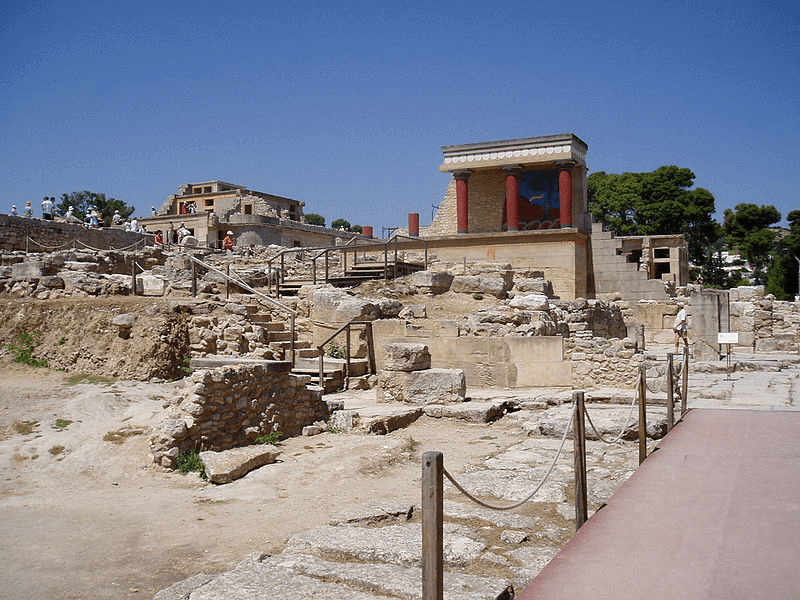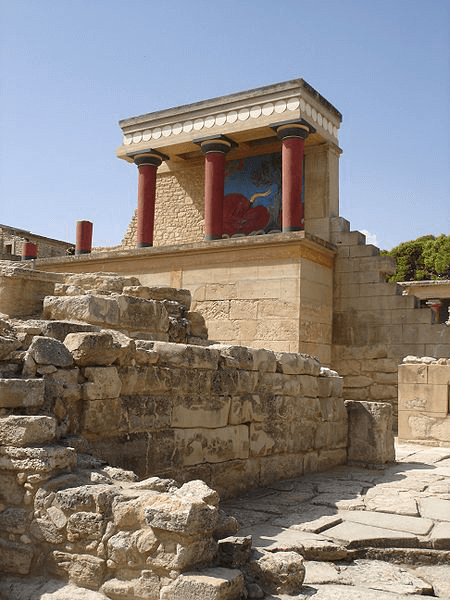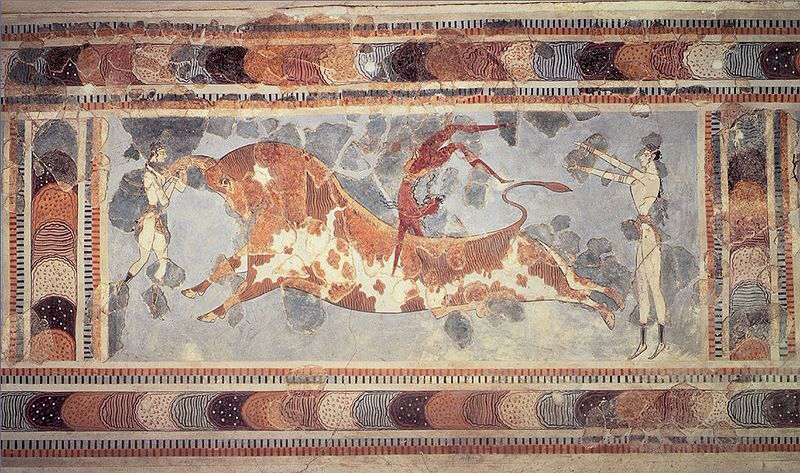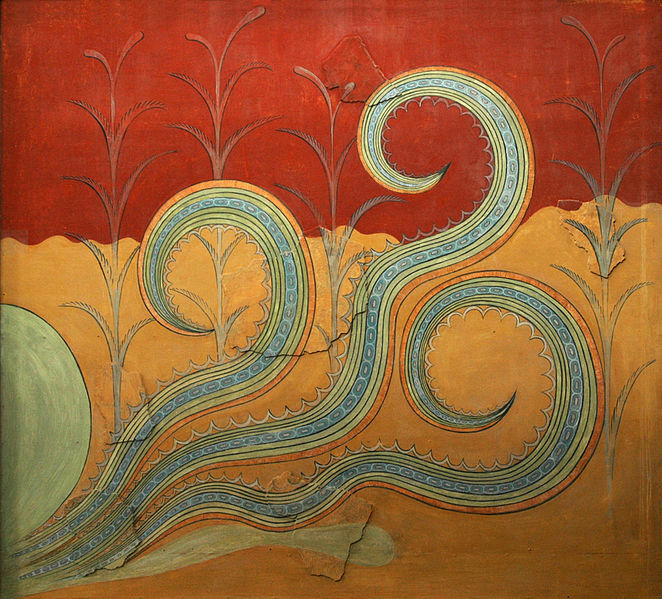Greek Settlements > Knossos
Knossos
Background
The ancient city of Knossos (Kuh-nuh-SOS) was the capital city of the ancient Minoans who resided in the city-state of Crete. The Minoans are a fantastic and mysterious civilization that is only recently begun to be uncovered. It is famous for being destroyed in the cataclysmic Thera Eruption along with the rest of Minoan culture.
Some even believe that the city of Knossos is actually the city that Plato identifies as his Atlantis however, this is open to debate. The city of Knossos was important for its development and participation in the maritime trade network that existed in the Mediterranean Sea at this point in time.

Palace at Knossos - Crete
This most likely led to an interaction between the civilizations of Greece and Phoenicia who were also engaged in widespread maritime trade at this time.
The city itself was known to have been destroyed and rebuilt at least twice.
Origins
The original settlement of Knossos was known to have been started at least by 2000 BCE. The first ruler was known to have been a man named King Minos. It was to be his name that would later be given to the civilization that existed on Crete at this time, called the Minoans.
King Minos was known to have built a grand palace on the island around 1900 BCE on the ruins of a much older settlement. So who knows how long people had really inhabited the island for. Based on archaeologists excavations the first palace of Knossos had very thick walls and was massive in size.

Knossos Palace - Crete
According to archaeologists, pottery samples suggest a lack of unified culture at the time and the palace was constructed as it was most likely for defensive purposes. This means the rule of Knossos was probably subject to contention during this early period.
There was an ancient language, known as the Cretan Hieroglyphs however, no one has been able to decipher their meaning since no bilingual documents are available for translation. Nothing is really known about this city or the culture of the ancient Minoans due to this inability to translate their language.
The first palace was destroyed around 1700 BCE and was rebuilt on a grander scale in terms of architecture, design and artistic detail. There was less effort spent on defensive walls which means the reign of the elite must have been more secure during this period.
Destruction
Knossos is known to have been destroyed about three hundred years after his establishment by both environmental factors and external invasion. Some claim it was by fire, others by a tsunami however, this argument is irrelevant as a powerful enough earthquake could have caused both of these phenomena and then some.
The earthquake that destroyed Knossos has long been associated with the Thera Eruption that occurred around 1600-1500 BCE that occurred on the island of Thera/Santorini. This major geological catastrophe triggered the destruction of the second great palace at Knossos and triggered the demise of the Minoan culture.

Knossos Bull Fresco
The Minoan culture was never able to recover after the destruction of their city yet their memory and culture continued to live on through assimilation into Greek and later Roman culture.
For example, the Roman lore features the island as home of Minos and the home of the Minotaur. There are coins minted in Rome that depicted the Minotaur who was a bullheaded man that stalked the character of Theseus throughout the Labyrinth of Minos.
Re-Discovery
Knossos was lost to modern times until its re-discovery by Arthur Evans who was an English journalist and scholar in the early 1900's. During this period the Christian and Muslim populations of Crete were struggling for independence against the larger Ottoman Empire so he had to go through much red tape before he was allowed to excavate.

Knossos Fresco
Evans was able to manipulate the situation by extensively covering the massacres committed in order to get the British Empire involved in the war and to protect his excavation. Once the civil war had ended the excavation really went ahead and rediscovered the entire sprawling palace complex that was lost at Knossos. There were living areas, store rooms, political centers and artwork and murals adorned all of the walls.
Overall the rediscovery of Knossos is very important to understanding the very mysterious Minoan culture. Until we are able to translate their language it appears they will continue to remain a mystery to us. As to weather the city is what Plato referred to as his Atlantis, highly doubtful.
Sources
- Abacaenum
- Abbassus
- Acropolis Of Athens
- Aegean Settlements
- Aegyssus
- Agde
- Agia Irini
- Aiani
- Akragas
- Akrotiri
- Al Mina
- Alexandria
- Amisos
- Amnisos
- Amphipolis
- Ampurias
- Amyntaio
- Ancyra
- Anthedon
- Antipolis
- Antipyrgus
- Aphrodisias
- Apollonia Arsuf
- Apollonia Pontica
- Apollonia
- Argos
- Arkadiko Bridge
- Arna
- Asine
- Assiros
- Assos
- Astacus In Bithynia
- Astibus
- Athens
- Bathus
- Berge
- Black Sea Greek Settlements
- Borysthenes
- Bosco Littorio
- Boura
- Bylazora
- Byzantium
- Callatis
- Carian Settlements
- Chalcedon
- Chalcis
- Chersonesos
- Cibrya
- Cilician Settlements
- Cius
- Classical Athens
- Clazomenae
- Colophon
- Corcyra
- Corinth
- Cotyora
- Croton
- Cycladic Settlements
- Cyme
- Cyrene
- Darieium
- Delium
- Delos
- Delphi
- Dendra
- Dicaearchia
- Didyma
- Dimini
- Dionysopolis
- Dioscurias
- Dispilio
- Doric Hexapolis
- Doric Pentopolis
- Dorieium
- Dreros
- Edessa Greece
- Edessa
- Eileithyia Cave
- Elaea
- Elateia Epirus
- Elateia
- Ephesus
- Epidaurus
- Epizephyrian Locris
- Erythrae
- Eryx
- Eudocia
- Euonymeia
- Eupatoria
- Franchthi Cave
- Gla
- Gordium
- Gorgippia
- Gortyn
- Graea
- Greek Egyptian Settlements
- Hagia Photia
- Hagia Triada
- Hagios Onouphrios
- Halicarnassus
- Helike
- Heraclea Minoa
- Heraclea Pontica
- Heraklion
- Hermonassa
- Hierapolis
- Histria
- Hyele
- Ichana
- Iklaina
- Iolkos
- Ionian Settlements
- Jandial
- Kalapodi
- Kalaureia
- Kamares Cave
- Kannia
- Kea
- Kepoi
- Kerameikos
- Kerasous
- Khalandriani
- Kibrya
- Kimmerikon
- Knossos
- Komnina
- Koukonesi
- Krounoi
- Kydonia
- Kynos
- Larissa
- Laurium
- Lebedus
- Lefkandi
- Lerna
- Lycian Settlements
- Macalla
- Magna Graecia Settlements
- Magnesia On The Maeander
- Mainake
- Manika
- Marathon
- Massalia
- Megalopolis
- Megara
- Mende
- Menelaion
- Mesembria
- Messena
- Midas City
- Midea
- Milesian Colonies
- Miletus
- Minoa
- Minoan Settlements
- Mitrou
- Monastiraki
- Monoikos
- Mycenae
- Mycenaean Settlements
- Myrmekion
- Myrtos
- Myus
- Nacona
- Naucritis
- Naulochos
- Naxos
- Nea Nikomedeia
- Nemea
- Neolithic Greek Settlements
- Nicaea
- Nichoria
- Nicomedia
- Nikonion
- Nymphaion
- Olympia
- Olynthus
- Orchomenus Arcadia
- Orchomenus Boeotia
- Orchomenus
- Oreus
- Palaikastro
- Panticapaion
- Parthenope
- Pella
- Pellana
- Pentopolis
- Pergamon
- Phaestos
- Phanagoria
- Phasis
- Pheia
- Philippi
- Phocaea
- Phrygian Necropolis
- Phyle Cave
- Pithecusa
- Pityus
- Poliochne
- Polis Chrysochous
- Pontic Athens
- Pontic Olbia
- Poseidonia
- Posideium
- Poti
- Priene
- Pteria
- Pylos
- Pythagoreion
- Rhamnous
- Rhegion
- Rhode
- Rhodes
- Samos
- Sardis
- Selinunte
- Sesamus
- Sesklo
- Sicilian Greek Settlements
- Sinope
- Smyrna
- Soli
- Sounion
- Sparta
- Stobi
- Stratonis
- Sybaris
- Syracuse
- Tanais
- Taras
- Tarsus
- Tenea
- Teos
- Thebes
- Themiscyra
- Theodosia
- Thonis Heracleion
- Thorikos
- Tiryns
- Tium
- Toumba
- Trachis
- Trapeza
- Triglite
- Tripolis Ad Maeandrum
- Tripolis Larisaia
- Tripolis
- Troy
- Tyras
- Tyritake
- Tzanata
- Vaphio
- Vari Cave
- Vasiliki
- Vergina
- Xanthos
- Zancle Messene
